
Features
Crop Culture
Inputs
Growing Points: When good crops go bad
May 14, 2014 By Dr. Mohyuddin Mirza
Traditionally, we have looked at energy as heating and electrical applications used in greenhouses.
Traditionally, we have looked at energy as heating and electrical applications used in greenhouses. When we talk about energy conservation, we generally talk about efficiencies of heating systems and reducing electricity use.
I think we have not given due respect to energies within the plant – that is, the “internal” energy. Once that internal energy is disturbed, all the external energy inputs are wasted. The result is an economic loss to the grower, to the business and to the industry.
So when I see problems in greenhouses, I always think of energy wasted, albeit sometimes due to accidents that are preventable and sometimes due to a lack of knowledge of the working of plants.
During the season from January to May, I get involved in diagnosing problems both with bedding plants and vegetables.
This month, I want to share some of these situations with you. It is not only about the diagnosis, but also about what to do after the correct diagnosis has been made.
I am only happy after plants recover and reach a saleable stage. Every year is a learning experience.
I am also discovering how many growers have access to cellphones and digital cameras. I get good quality pictures fast. Sometimes the problem can be diagnosed quickly, but sometimes a site visit becomes necessary.
Here are few actual examples where energy was wasted, and in some cases economic losses did occur.
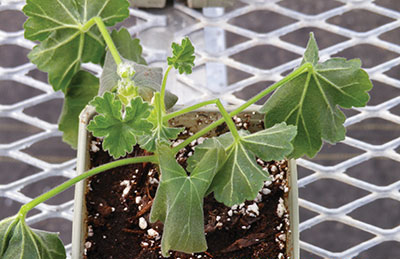
|
|
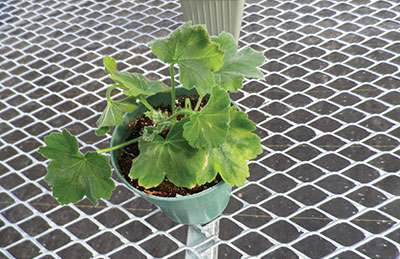 |
These recently planted geraniums got the shock of their lives when a vent malfunctioned and cold air came in. The temperature was close to 4 C for over five hours. The geranium at left was seriously damaged, while the geranium at right was less affected.
The plant at right was located away from the vents. One can see edema on the leaves on the plant at left. The grower was advised to throw these plants away and bring in new ones.
Obviously, the grower did not have an alarm system hooked up into his bedroom. Many gadgets are available now to set up alarms or video monitoring through your cellphone.
Serious energy loss, and of course serious economic loss, occurred here. Don’t try to hang onto those seedlings with the hope the damaged leaves may be removed and new growth will be normal. In this case, the roots were damaged as well.
ROOTING THE UNROOTED CUTTINGS
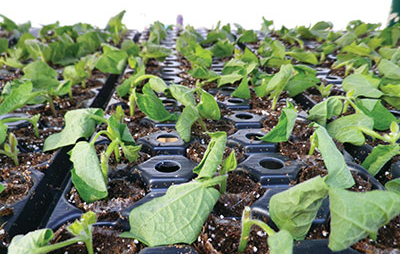
|
|
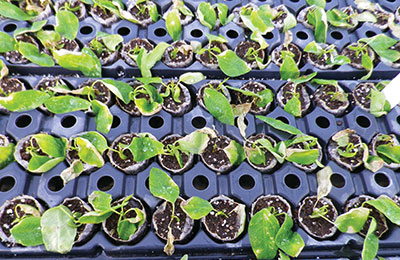 |
This was an interesting situation where the unrooted cuttings were stuck for rooting, but they were not immediately moved under mist – the delay was more than 30 minutes. The leaves started shriveling and damage was evident.
That day, the relative humidity was 23 per cent in the area where the cuttings were being stuck.
The grower has since improved his practices by immediately misting by hand and then moving the trays quickly to misting stations.
However, the damage was done. In early April, I received the picture at right; this shows how the grower who received this tray was concerned about leaf tips browning. One can see how a simple problem became an issue when the plants were finally delivered.
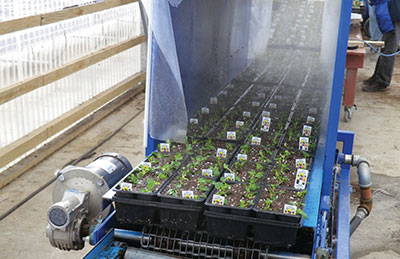
|
|
Many growers use these misting chambers immediately after transplanting cuttings, either rooted or unrooted. This is very helpful for the plant.
I recommend that growers start with a moistened growing medium and not a dry one from the bale. If a totally dry medium is used, then it will take time to completely wet the medium, even after going though the misting chamber.
Sometimes the complete wetting is not done for weight reasons. As long as the starting growing medium is moistened and the soaking is done up to the depth of the plug – and then thoroughly soaked at benches – the plants will be happy to produce good roots and a good quality plant.
CALCIUM DEFICIENCY IN CUCUMBERS
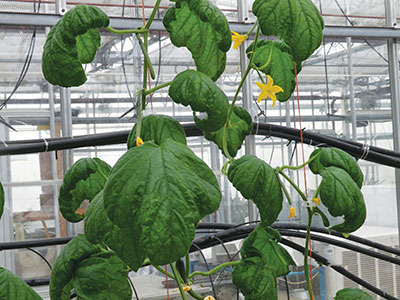 |
|
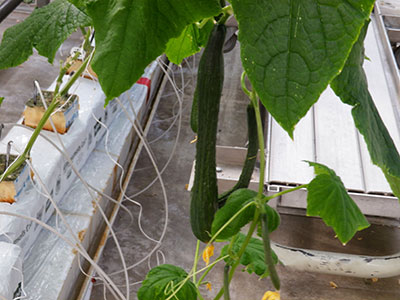 |
The picture at left is a cucumber crop showing signs of a serious shortage of calcium. The cupping of young and recently mature leaves is an indication of calcium shortage.
The reason is that calcium is not mobile within the plant. Even though sufficient calcium is present in the feed solution, it may not be supplied to young leaves because of high relative humidity and the fact water is not moving through the plant.
The problem can be corrected by dehumidification and making sure there is enough calcium in the feed, that pH is in the proper range, and that the moisture deficit is between 3 and 7 grams/m3 of air.
The picture at right (previous page) is a cucumber plant showing potassium deficiency in the fruit. The fruit has a “dumbbell” shape.
I have seen that a temporary shortage of potassium can occur in fast growing crops. This is due to a very heavy fruit load and a shortage in the reserves of the growing medium as well. Potassium is a highly mobile element. Plants can store it for some time and use it where needed. The shortage makes fruit unsaleable due to resulting taste changes.
TWO TYPES OF DAMAGE ON CUCUMBER LEAVES
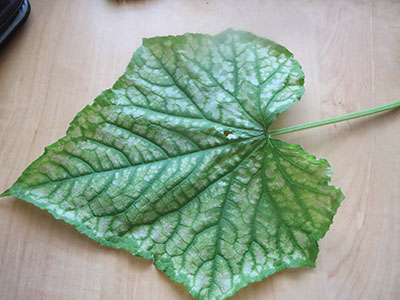
|
|
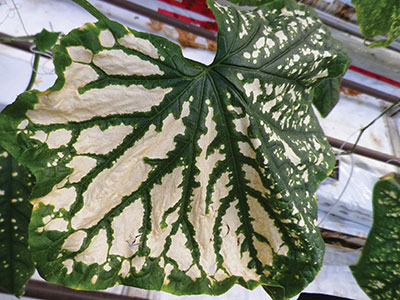 |
The picture at left side is damaged due to temperatures dropping below 10 to 12 C for three hours. The photo at right shows damage due to a spray of a concoction of vitamins, minerals and humates at the recommended rate.
There are many formulations in the marketplace that claim to result in better growth and higher yields. When I checked the E.C. of the recommended spray solution, I found that it was over 5.0 mmhos. Growers should understand what they are doing; they should spray a few plants before spraying the entire crop if they are not sure.
EDEMA ON TOMATOES
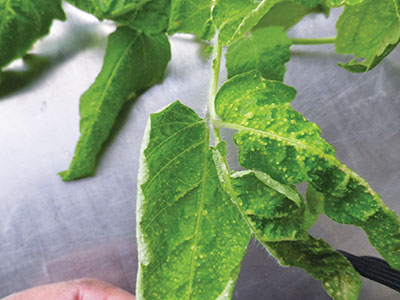 |
|
This image shows symptoms of edema on tomatoes. It can happen in early crops, especially under low light conditions. The leaf cells are not mature enough and a rapid drop in temperature can cause the cells to burst. The damage is permanent, and growers should work on correcting the temperature ramping. Keeping higher EC levels of fertilizer solution in January will help to reduce the incidence of edema.
RUST ON FUCHSIA
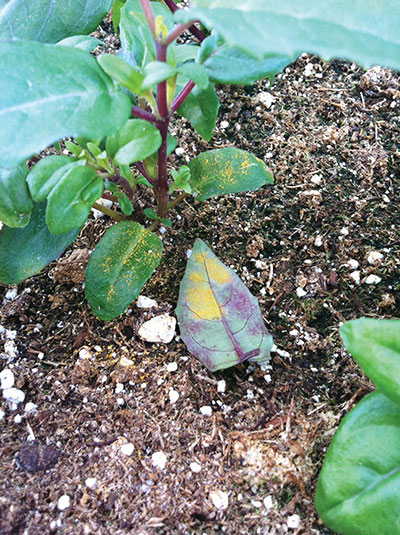
|
|
Rusts on Fuchsia was reported by one grower and one propagator. Rusts are specific to hosts and will not move to other crops. Remove the affected leaves and use recommended fungicides or other available options. Ask suppliers and propagators to suggest measures to control rusts.
LEAF DAMAGE ON WHITE MILLION BELLS
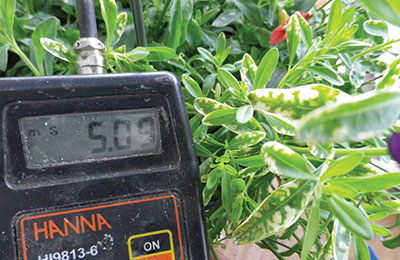 |
|
This was a very interesting situation in which a grower sent me pictures of a hanging basket of Million Bells plants. One plant showed the symptoms of white spots on the edges of only one variety.
When I went to see the plant and checked the EC via a pour-through method, it was at 5.07 mmhos, which I believed was high enough to cause the observed problem.
However, some of the baskets with lower EC showed similar damage. On further investigation, it was found that the grower had used a product for thrips that is generally recommended for outdoor crops. It is quite possible the damage was caused by this spray. Growers should be careful with the use of such sprays. We are now watching how the new growth is coming up. If one plant in a hanging basket is affected, it will make the entire basket unsaleable.
ALKALINE pH ISSUES WITH LILIES
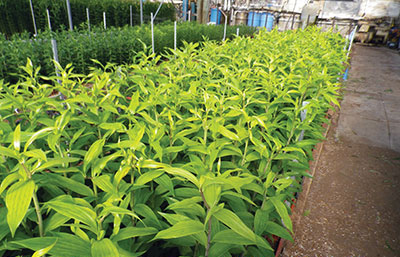
|
|
This crop of lilies being grown in coir showed the typical symptoms of yellowing due to iron deficiency. This was traced to an alkaline pH caused by an issue with an acid-dosing pump. The grower did not notice the issue until the symptoms became evident. Obviously, the solution was to correct the feed pH to proper levels.
CALCIUM DEFICIENCY IN GERANIUMS
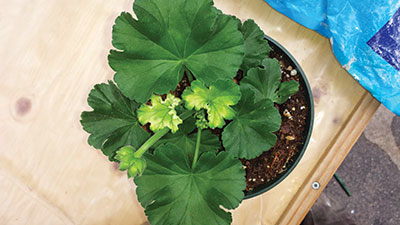 |
|
I am finding that growers are not paying attention to the use of calcium in feeding programs for bedding plants. They think that 20-20-20 is a “complete” fertilizer. It does not contain calcium. Some growers have only one injector and they alternate the calcium feed with the regular feed of 20-20-20 or 20-10-20. This was a case where calcium deficiency was indicated and the new bud was especially affected.
POWDERY MILDEW ON BIDEN
Finally, I want to share this picture of powdery mildew on bidens. This fungus is being observed more commonly now in many bedding plants, especially the ones that require high nitrogen, need more vegetative growth, and become generative very quickly due to higher EC in the leach solution.
There are many good products available, but the key is to start using these products very early. The mildew reduces the photosynthetic area of leaves and affects the new growth. This fungus is the opposite of Botrytis, in the sense that it prefers dry conditions to produce spores but it still needs water droplets to germinate.
Dr. Mohyuddin Mirza is a greenhouse consultant. drmirzaconsultant@gmail.com
Print this page